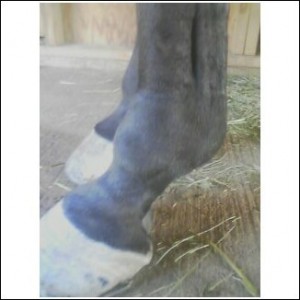| Home Medical Index | First Posted Jan 3, 2010 Jan 21, 2020 | |
Osselet in Horses Osselet is arthritis in the fetlock joint of a horse.
Location Osselets usually occurs in the front legs of the horse, because there is more strain and concussion on the fetlock there than in the hind legs. The arthritis will occur at the joint between the cannon bone and large pastern bone, at the front of the fetlock. Causes and Progression Osselets is caused by stress on the fetlock, which results in a stretching of the joint capsule. The early stage is called green osselets, and is characterized by a hot, soft swelling at the fetlock. If inflammation damages the cartilage of the joint, the swelling may become chronic and permanent. The joint capsule may also thicken. Eventually, the bones of the joint will become involved, causing arthritis, pain, stiffness, and periostitis (new bone growth). The fibers of the joint capsule will also increase in size. The long pastern bone may also eventually chip at its front edge, which will leave bone fragments in the joint. Conformation that encourages osselets to occur include short, upright pasterns, because this conformation promotes concussion. "Osselets refer to an inflammation, usually bilateral, of the periosteum on the dorsal distal epiphyseal surface of the third metacarpal bone and the associated capsule of the fetlock joint. The proximal end of the first phalanx may also be involved. Hence, osselets constitutes a form of periostitis and serous arthritis that may progress to degenerative joint disease. The exciting cause is the strain and repeated trauma of hard training in young horses and is recognized as an occupational hazard of the young Thoroughbred. The gait is short and choppy. Palpation and flexion of the fetlock joint produce pain, and examination reveals a soft, warm, sensitive swelling over the front and sometimes the side of the joint. Radiography in the initial stages may show no evidence of new bone formation, in which case the condition is called "green osselets." Later, enthesopathy may be seen in the area of attachment of the fetlock joint capsule to the large metacarpal bone and first phalanx. New bone or spur formation may break off and appear as "joint mice." Rest is very important and can be curative for early cases. The inflammation may be relieved by the application of cold packs for several days. Systemic anti-inflammatory drugs such as phenylbutazone may also be used. Corticosteroid can also be injected intra-articularly; however, this and other forms of anti-inflammatory medication, if used along with continued training or racing, inevitably lead to destruction of the joint surfaces. Intra-articular sodium hyaluronate is useful to reestablish normal synovial viscosity." Osselet/Merck Vet Manual |